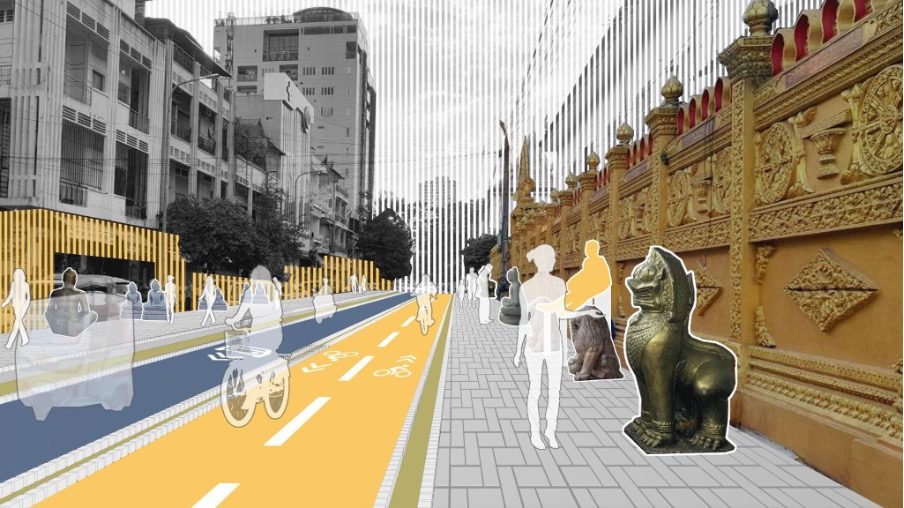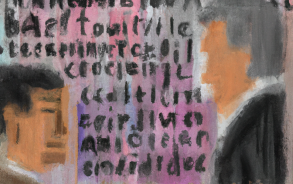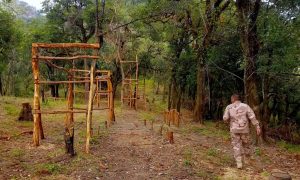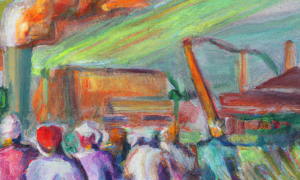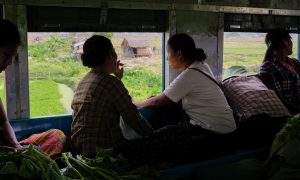Large parts of Phnom Penh still showcase French colonial ideas about urban design that were in vogue during the late 19th and early 20th centuries. The French introduced European architectural styles, urban design principles, and administrative systems that left a lasting impact on the city’s layout and aesthetics—look, for example, at the areas surrounding Wat Phnom, the city’s main Buddhist temple, and the Royal Palace, where some colonial architectural designs and urban layouts are still present.
During colonial times, transformations for Phnom Penh had a dual purpose. They presented the city as a modern and efficient urban centre, with the aim of garnering support from Paris, and they were geared towards attracting new investments and facilitating the arrival of additional European colonisers.
The primary aim of this plan was to position the city as a forward-thinking urban centre. Consequently, the city’s master plan centred around two key attributes: order and cleanliness.
While Phnom Penh’s urban origins were highly planned, the transformations happening all around us in the city today tell a different, but no less important story.
Even after independence, another form of colonisation took over the streets of Phnom Penh—this time not by a nation but by private motor vehicles, which consume space from people more and more. With sidewalks surrendered to car parking, reinforced by a belief from both authorities and citizens alike that parking on the sidewalk is the correct move since it frees up space for traffic.

Sidewalk along Chen Dom Dek pagoda being used as parking space. (Photo by Prak Norak)
Despite this “colonisation”, many of the smaller, more personal, alterations to Phnom Penh’s urban landscape that are happening today occur in a spontaneous, people-driven way.
Much of these changes could be classified under a category of urban design often referred to as “tactical urbanism.” To put it simply, “tactical urbanism” is the transformation of urban space through DIY or low-cost approaches. The main purpose is to revitalise an urban space through fast and cheap actions. It can be done by citizens or any actors but in a very informal way.
If for instance some residents believe they need some greenery, they plot a pot of plants on a corner of the street. If they want some seating, they’ll place a bench. All of which requires little design or budget to do. And it can be done almost by anyone in the neighbourhood, if they are so inclined.

Residents plotting some greeneries along an alleyway at Chen Dom Dek community. (Photo by Prak Norak)
In Phnom Penh, however, it might be better to refer to it as “spontaneous tactical urbanism” because these changes often happen almost unknowingly. These initiatives happen without any coordination between different actors. One citizen sees another put a plant in front of their house, and they decide to put one up as well. The other has a coffee stall in front of their house and a few weeks later they’ll see vendors come flocking to sell too.

Vendors at an abandoned spot near Pannasastra university. (Photo by Prak Norak)
These are the small, informal ways that Phnom Penh residents are making urban spaces their own.
Rather than seeing these types of changes as a total mess or chaos, we should instead view these informal uses of the street and public spaces as a form of public space “decolonisation” or “liberation” from restrictions and excessive parking space. With that in mind, future planning of the city should create and preserve public spaces that have the potential for reinterpretation.
Informal transformation of public space shouldn’t be taken completely as a disruption to the public. Rather they should be encouraged and socially enhanced.
History’s impact on the present day
Today, like many rapidly growing cities, Phnom Penh faces a range of urban problems that impact its liveability, sustainability, and its current and future development. These challenges are reflected in the city’s often contentious relationship with its history.
One of the reasons Phnom Penh — a jewel in colonial times and a modern city during the 1950s and 60s — lost its fervour is due to the long decades of war in Cambodia that halted the city’s advancement. It was not long after the 1960s, that the city was beginning to decline until war reached it. After the 1990s, the city is still trying to recover itself from the ground up.
The impact of those dark decades is still felt to this day, with houses made secure with iron bars and high walls along certain properties. There is a longing to connect between citizens, yet their wariness is expressed by those high walls, heavily protected openings in houses, and desolate streets during the night.
Translating atrocity at the Khmer Rouge Tribunal
The ECCC highlights some hazards of miscommunication and mistranslation in multilingual war crimes proceedings
These infrastructure deficits also translate to socioeconomic disparities with low-income neighbourhoods failing to receive even the most basic infrastructure including clean water, sewage systems, and waste management services. This wealth gap is further widened by the increasingly limited public space, especially green spaces that can only be seen mostly in gated communities known as Borey.
More importantly, with the increase of indoor businesses and shopping malls, street businesses are being challenged. With street businesses having been a staple of Phnom Penh and many Asian cities, it also means the city’s identity and history are contesting with its development.
Addressing these urban issues requires an comprehensive approach that involves residents, authorities, civil society organisations, and urban planners. As with different example cases in Europe and China, revitalisation projects are carried out with people’s voices as a priority, which serves to build relations between the government, different stakeholders, and the citizens.


This and above: students consulting with locals of street 178 about redesigning their street as part of their workshop (Photo by Ses Aronsakda)
One such collaborative approach was initiated back in 2023 by Future Forum and the Lee Kuan Yew’s Centre For Innovative Cities as an inter-disciplinary workshop. Students from the mobility field, along with architecture students, are brought to the table to redesign street 178 and street 184 as pedestrian-friendly. Before the design session, the mobility students consulted with both commuters and locals in the area to try and capture their voices and opinions. Much of their discussion led to the formalisation of what the locals already did to the streets. The result was a pedestrian-friendly street that provide various amenities supporting the local artists, sculptors, street vendors, students in the area, cyclo-men and shop owners.

Part of the street redesign was to acknowledge sculptors uses of the sidewalk and create a ‘gallery sidewalk’ for them (Illustration by Prak Norak)
Phnom Penh must overcome the limitations resulting from its historical context and become a more liveable, equitable, and resilient city. However, starting anew by completely clearing or leveling parts of the city, or even demolishing existing buildings and infrastructure, isn’t the answer. This is reflected by the destruction of historic buildings in Phnom Penh to make way for new developments. Or public spaces that are often built only in a flat empty land for a Borey rather than in an existing built-up area.
Instead, approaches and interventions in Phnom Penh should be more incremental or based on adaptive methods that seek to build upon existing, once deemed modern urban fabric. As an example of this, we might look toward the ways tactical urbanism can lead to a social revitalisation of the city’s sidewalks.
Spontaneous tactical urbanism in practice
Phnom Penh’s sidewalks are often described as “unwalkable” due to the modification done by locals. But under the principle of spontaneous tactical urbanism, much of what happens on these sidewalks is also positive in its liveliness, vibrancy, and inclusiveness.
Take street vending as an example, particularly when these vendors set up near walled off sidewalks or in front of a shop or closed property. On street 178, north of Royal University of Fine Art, a group of vendors selling banh trang rice paper rolls and other foods have created an identity for the street and a landmark to both students of the school and passers-by. These actions are a type of placemaking crafted unknowingly by the citizens without any formal planning.

Vendors at street 178 (Photo by Ses Aronsakda)
However, street vending is sometimes viewed as an annoyance or hindrance to traffic and public order by the authorities. Still, the impact of reinterpreting existing infrastructure creates a livelier and safer street, should not be dismissed.
Professor Cheam Phanin, an urban design studio supervisor from Pannasastra University of Cambodia and Norton University, said during an interview that “street vending on sidewalks isn’t necessarily bad. It contributes to the liveliness of the city and is convenient for people of middle income who would prefer street foods over restaurants.” If we really were to take away street vending from the sidewalk, we wouldn’t just lose our convenience but also the animated life from the street and its local identity.
Another form of tactical urbanism is street art that is more colourful literally and even sometimes “spontaneous”. Although it only get mainstreamed in the past few years, street arts have been around for quite sometimes in Phnom Penh in abandoned buildings or walled-off desolate streets.
These locations are the perfect canvas for artist and the spots that are in need of revitalisation. In a recent project called Street Life at Chen Dom Daek, university students get to paint an alleyway into a more vibrant space. This approach is simple but has been conducted in many other countries to great success. What would otherwise be a desolate street can be turned into public gallery for the citizens; it adds a touch of personality.


Street arts drawn by students and young children living in the alleyway community] photo by Prak Norak
Another issue with current practice is that while the use of sidewalk as a parking space is acknowledged, the use of sidewalk as a public space is met with disapproval. Authorities would often tell vendors to go somewhere else because they’re disrupting traffic or being disorderly. The main concern is always toward allowing road traffic to flow rather than having space to accommodate pedestrian traffic or activities. It became apparent with many road infrastructural development in the last decade is toward mostly enlarging motor roadway but not pedestrian sidewalks or infrastructure. Yet it was always branded as a form of revitalisation, even though it has only led to more road traffic and increased parking—in our words, “being colonised by vehicles”.
Therefore, any sort of intervention and revitalisation should acknowledge current use and features that have been spontaneously designed to create inviting and safe spaces by locals, that encourage pedestrian activity, social gatherings, cultural expressions, and economic activities.
With that in mind, future planning of the city should embrace the potential for reinterpretation. No city should ever be static. Creating spaces that are flexible for the people isn’t just a benefit for street vendors but also making sure they serve as a canvas for Phnom Penh’s citizens to be creative.
A city planned for its people
The cultural identity of the city as a whole is defined not just by the urban layout and physical structure but also by the people who inhabit it. Sometimes the eyes of the users see what the planners may not. So what will they make of this grand canvas of a city?
One painted a desolate wall as a backdrop for an eatery, another painted a sidewalk as a picnic ground, and even potentially an art exhibition.
This is why preserving and enhancing the strength and distinctiveness of cities like Phnom Penh is vital. Rather than relying solely on large-scale design and radical changes, this can be accomplished through, locally inspired, temporary or semi-permanent interventions.
Furthermore, acknowledging the significance of spontaneous and informal uses of urban spaces, not only in economic terms but also as a means of promoting placemaking, while reconciling with its colonial lineage, is a key step in recognising people’s right to the city.
However, it is not only cities with a defined urban structure, whether inherited from colonial lineage or visionary planning like Phnom Penh, that can benefit from this approach. Other cities in Southeast Asia, even those with indigenous quasi-rural characteristics in their genealogy, can also capitalise on this aspect. An example of this can be seen in the numerous urban villages or kampung in cities like Jakarta. These areas are increasingly under siege by large real estate corporations, which are virtually eradicating the last corners of community life in the name of urban revitalisation and progress.
Like many other metropolises in Southeast Asia, Phnom Penh is very much a city in permanent transition. The city’s “bones” might be colonial, but many of the most exciting and vibrant changes that are being made to the city are people-driven in a participatory and spontaneous manner.
By purposefully leaving an “unfinished” imprint or challenging discourses and policies that scorn or prevent informal planning processes, residents assert their presence and reimagine the city according to their changing needs and aspirations. Learning from the case of Phnom Penh, citizens in sprawling urban areas across Southeast Asia and beyond can challenge top-down urban development paradigms dictated by city governments and private interests. By appropriating and repurposing different spaces, residents can advocate for more participatory approaches to city-making, shaping the city into a more inclusive and home-like environment.
 Facebook
Facebook  Twitter
Twitter  Soundcloud
Soundcloud  Youtube
Youtube  Rss
Rss 